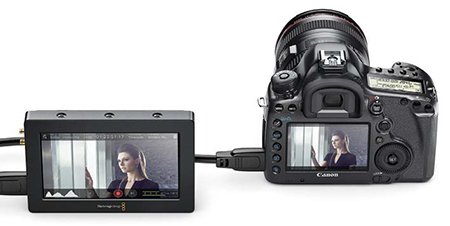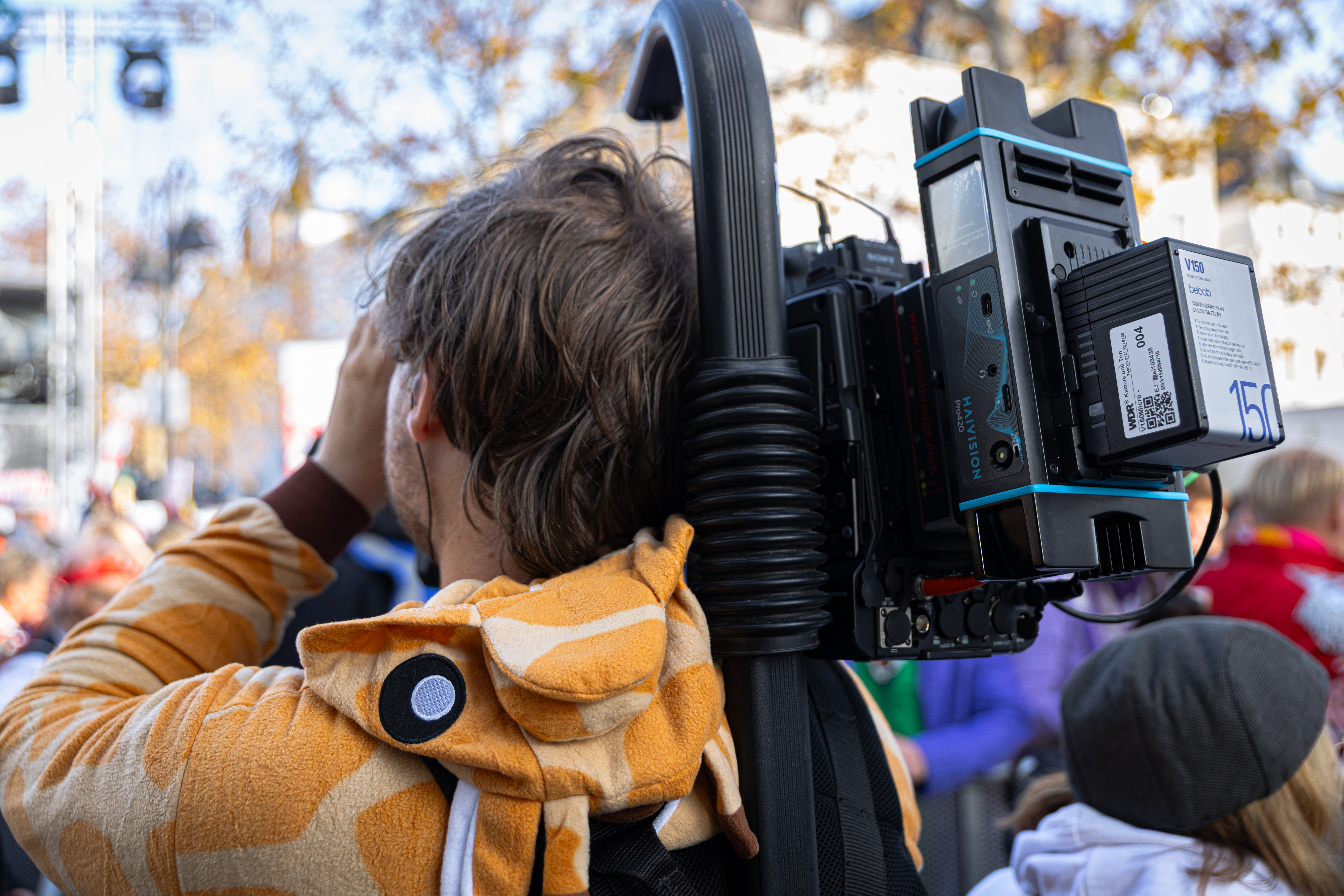Pro Video Monitors Run the Gamut of Features

Blackmagic Design introduced its Video Assist 5-inch touchscreen monitor/recorder at the 2015 NAB Show.
PADUCAHY, KY.—It wasn’t that long ago that getting monitors to “agree” in a production control room was a full-time job. (Anyone who ever carried around a blue filter in their pocket will certainly understand.) Lately though, improved reliability and more features, along with high resolution, color match, and high contrast ratios have been just something broadcasters have come to expect.
FEATURES AND GADGETS
Broadcasters love technology (except when they hate it), and one sure way for equipment manufacturers to get their attention is to add value to their monitors, when it comes to multi-tasking.
“We put everything you can think of into these monitors,” said Wes Donahue, director of channel sales and marketing for TV Logic, in describing the new monitors the company launched at the 2015 NAB Show. Those new features include audio metering, timecode, waveform/vector-scope, multiple inputs, focus assist, HV Flip, Key Lock, and Luma Zone Check.
Ray Kalo, president of Plura Broadcast in Phoenix, noted the variety of customers looking for more feature-filled professional monitors now. Among the more popular features on Plura’s monitors are LKFS audio monitoring and logging, audio de-embedding, V-Chip decoding, HDMI preview output, waveform/vectorscope, multiple SFP slots, HD-SDI, SDI with active loops, fiber and coaxial connectivity, SDI to HDMI conversion, and even a built-in 6 x 6 cross point switcher.
With van and truck space always at a premium, Marshall expects their new Lynx 503 5-inch HDMI, composite, SD/HDSDI monitor to be a hit, along with their popular M-Lynx 702 dual 7-inch, which includes tilt view, physical knobs, and optional WFM/vector. “There have been a lot of changes in the past three or four years with regard to what our customers demand,” said Devan Cress, director of sales,
Broadcast AV Division for the El Segundo, Calif.-based company. According to Cress, their MD Series (modular) is a first with direct fiber-optic inputs, using Telecast Fiber’s (Grass Valley) TeleCube modules, with other features including H/V delay, IMD, tally, HDMI, test signals, modular input slot, adjustable backlight, loss of input curtain, and more.
The professional video industry's #1 source for news, trends and product and tech information. Sign up below.
Another endorsement of how fast the monitor industry is changing comes from Bob Caniglia, senior regional manager, Eastern North America for Blackmagic Design. “One big change over the past few years, industry-wide, has been the demand for screens on the front of control panels,” he said. In addition to Blackmagic’s Smartview Duo, Duo with WFM/Vector, and the Smartview 17—which all feature tallies and throughput—their 6G 1RU audio monitor features a built-in 2.1-inch real-time LCD monitor, HDMI out, and plenty of buttons on the front.
Regarding features, Gary Litwin, national sales director at Boland Communications in Lake Forest, Calif., had plenty to say about where the industry is going. “Broadcasters and production companies seem to need products categorized as ‘good,’ ‘better,’ and ‘best,’ and Boland has new product lines to supply those needs, including custom rackmount models for mobile, from 7-inches up to 20-inches, all the way up to the highest quality OLEDs.” Customers can find custom solutions via the Boland website by answering questions along the way, and Boland offers a rich feature set as well, including audio de-embed/monitoring, closed captioning, etc.

At the 2015 NAB Show, Plura expanded its PHB-3G Series of high-brightness portable LCD monitors with a new 7-inch model, designed for a wide range of broadcast mobile, indoor and outdoor applications.
4K/UHD AND BEYOND
Feature-rich products are not the only demands of broadcasters of late; much as faster cars require better tires, higher video standards are requiring display manufacturers to step up and deliver. HD was the first new benchmark in decades, but 4K is the latest generation, and it seems that there is no time to waste.
ITU-R Recommendation BT.2020—the latest benchmark for display manufacturers—is more commonly known by the abbreviations “Rec. 2020” or “BT.2020.” The recommendation defines various aspects of UHD such as display resolution, frame rate, chroma subsampling, bit depth, and color space. For cinema and high-end video productions where 4K has been the norm for awhile, it seems that camera-top displays are having to evolve at a fast pace as well. “It doesn’t matter how good the display is, if you can’t see it, it’s useless,” responded Litwin, referring to Boland’s new camera-top DayBrite Models with anti-glare, cross conversion, and off-axis viewing features.
For the best quality, Litwin points to OLED, and at this year’s NAB Show, Boland unveiled the BVB55OLED, one of the industry’s first 55-inch OLED professional monitors. “A few years ago, CRTs and plasma displays were making a run at hanging around,” he said. “I’m just glad they are gone, although if you run OLEDs at full bright, it does shorten their life.”
Kalo noted that resolution is just one aspect in determining the quality of an HD or 4K monitor; what about color tracking, contrast ratio, rate sampling, resolution, and gamut? “That’s one reason we provide automatic color calibration with Plura Intelligent Connection for Alignment and Calibration and 10-bit digital signal prcessing,” he said.
For 4K (or HD), Marshall offers their top-of-the-line Orchid, up to 32-inches, with features including tri-color tally, histogram, markers, and more. According to Cress, “4K seemed slow to gain traction, but at this year’s NAB Show, there was a huge amount of interest.” For camera-top, Marshall offers new full-resolution camera-top monitors, including a 7-inch and 10-inch. Cress says many 4K cams have HD1080 out, so these are a great fit.
Blackmagic Design hit the 4K market head-on in 2014 with their Smartview 16 4K, which features battery or internal supply, HV delay, blue only, zoom, peak, 3D LUTs, markers, and support for SD, HD, 3G, 6G, and 12G SDI sources, according to Caniglia. For camera-top, he touted BMD’s new Video Assist 5-inch touchscreen monitor/recorder, a 6G unit that uses two Nikon batteries, (drains weakest first), and can connect to DLSRs via HDMI to provide 10-bit recordings inside the Video Assist unit.
“There are two things happening in video display: 4K and watching HDR [high dynamic range],” said Donahue, who adds that, for consumers, 4K alone is not going cut it on its own; with a 55-inch or 65-inch screen, viewers have to be close enough to discern the resolution difference. “HDR is key with 4K to make a completely different look,” he said, adding that, in his opinion, the CEA gave their manufacturers “a pass” on the REC2020 [BET2020] spec, which has a wider color gamut, among other attributes.
Donahue acknowledged that he believes no manufacturer currently makes a monitor that can meet the entire REC2020 spec, but manufacturers are trying to provide what broadcasters need. At the NAB Show, TV Logic showcased the 31-inch 4K LUM-310a reference display for HD and 4K, which does about 75 percent of REC2020 and features 10-bit processing, about 1.07 billion colors, and a contrast ratio of 1450:1.
In today’s monitor market, there are a mixture of display types available, including LED, LCD (different backlighting schemes), and OLEDs. For 4K, applications can be digital cinema projection, multi-viewers with higher resolution (over HD), studio, field, camera-top, or in the home. One thing is for sure, 4K/UHD is here to stay, and so are monitors with creative features.
